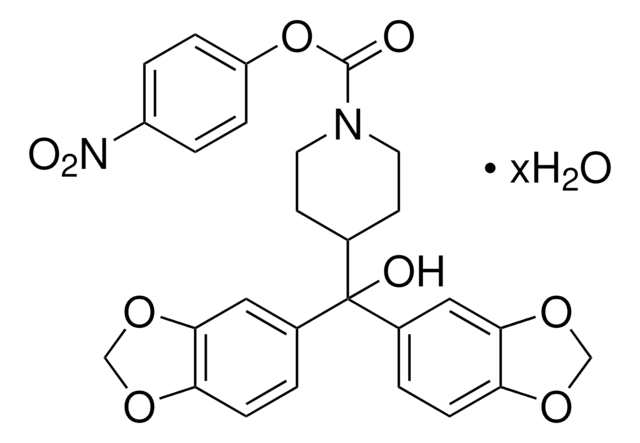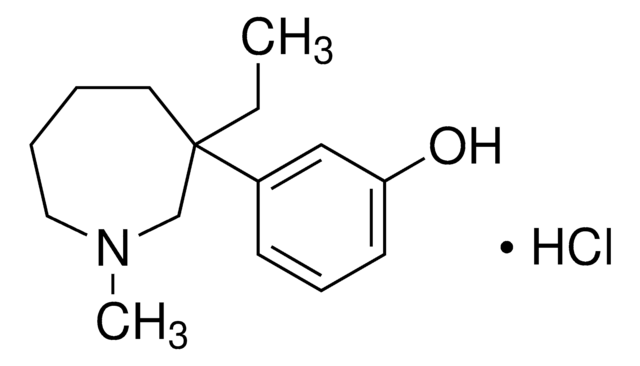推荐产品
化驗
≥98% (HPLC)
形狀
powder
顏色
white to beige
溶解度
DMSO: ≥5 mg/mL at warmed
儲存溫度
−20°C
SMILES 字串
[O-][N+](=O)c1ccc(OC(=O)N2CCN(CC2)Cc3cccc(Oc4ccccc4)c3)cc1
InChI
1S/C24H23N3O5/c28-24(32-22-11-9-20(10-12-22)27(29)30)26-15-13-25(14-16-26)18-19-5-4-8-23(17-19)31-21-6-2-1-3-7-21/h1-12,17H,13-16,18H2
InChI 密鑰
QNYRAEKLMNDRFY-UHFFFAOYSA-N
應用
JZL195 has been used:
- as a selective inhibitor of endocannabinoid (eCB) clearance enzymes to induce in vivo long-term depression at CA3-CA1 synapses and at prelimbic (PrL)-nucleus accumbens (NAc)synapses, to study the neuroprotective action of eCB
- to inhibit the action of hydrolytic enzymes that limit eCB activity, to study the effect of 2-linoleoylglycerol (2-LG) on the human CB1 receptor activity
- as a dual fatty acid amide hydrolase (FAAH)/monoacylglycerol lipase (MAGL) inhibitor to study its dose-related antipruritic effect on the serotonin (5-HT)-induced scratching model
生化/生理作用
JZL195 is a dual inhibitor of FAAH and MAGL.
JZL195 is a potent dual inhibitor of Monoacylglycerol lipase (MAGL) and fatty acid amide hydrolase (FAAH), enzymes that degrade the endocannabinoids 2-arachidonoylglycerol (2-AG) and anandamide (AEA), the endogenous ligands for the cannabinoid G-protein coupled receptors CB1 and CB2. IC50 values are 2 nM for MAGL and 4 nM for FAAH. JZL195 has been shown to inhibit endocannabinoid hydrolysis and elevate 2-AG and AEA levels in vivo.
儲存類別代碼
11 - Combustible Solids
水污染物質分類(WGK)
WGK 3
閃點(°F)
Not applicable
閃點(°C)
Not applicable
Feng Wang et al.
Journal of cerebral blood flow and metabolism : official journal of the International Society of Cerebral Blood Flow and Metabolism, 39(6), 1122-1137 (2018-02-13)
Ischemia not only activates cell death pathways but also triggers endogenous protective mechanisms. However, it is largely unknown what is the essence of the endogenous neuroprotective mechanisms induced by preconditioning. In this study we demonstrated that systemic injection of JZL195
Ozgur Yesilyurt et al.
Archives of dermatological research, 308(5), 335-345 (2016-04-30)
The increase of endocannabinoid tonus by inhibiting fatty acid amide hydrolase (FAAH) or monoacylglycerol lipase (MAGL) represents a promising therapeutic approach in a variety of disease to overcome serious central side effects of exocannabinoids. Recent studies reported that systemic administration
Tania Muller et al.
American journal of physiology. Endocrinology and metabolism, 313(1), E26-E36 (2017-03-23)
Evidence has accumulated that obesity-related metabolic dysregulation is associated with overactivation of the endocannabinoid system (ECS), which involves cannabinoid receptor 1 (CB1R), in peripheral tissues, including adipose tissue (AT). The functional consequences of CB1R activation on AT metabolism remain unclear.
Jose Iglesias et al.
Journal of lipid research, 57(1), 131-141 (2015-10-02)
Lipids are used as cellular building blocks and condensed energy stores and also act as signaling molecules. The glycerolipid/ fatty acid cycle, encompassing lipolysis and lipogenesis, generates many lipid signals. Reliable procedures are not available for measuring activities of several
Shivani Jaiswal et al.
Biomedicine & pharmacotherapy = Biomedecine & pharmacotherapie, 107, 1611-1623 (2018-09-28)
Fatty acid amide hydrolase (FAAH) represents a potential therapeutic target for number of peripheral and nervous system related disorders including neuropathic pain and neuroinflammation. A library of N-(2,4-dichlorobenzoyl) isatin Schiff bases 7a-7l and 8a-8c were designed using the contemporary scaffold-hopping
我们的科学家团队拥有各种研究领域经验,包括生命科学、材料科学、化学合成、色谱、分析及许多其他领域.
联系技术服务部门








